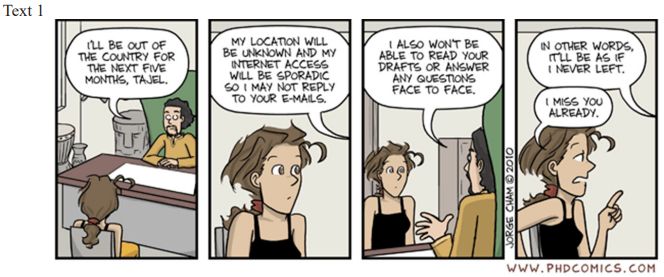Questões de Concurso
Para letras
Foram encontradas 214.401 questões
Resolva questões gratuitamente!
Junte-se a mais de 4 milhões de concurseiros!

Imagens in: CAPOVILLA, F. C., RAPHAEL, W. D., TEMOTEO, J. G., MARTINS, A. C., Dicionário da Língua de Sinais do Brasil: A Libras em Suas Mãos. 1. ed. 1. reimpr.- São Paulo: Editora da Universidade de São Paulo, 2017. p. 244, 929, 1409, 2036, 2297, 2488.
“Os sujeitos “ouvintes”, que podem ser os alunos de cursos de línguas de sinais, família, professores de inclusão, professores bilíngues, intérpretes, amigos e outros, são encorajados a ver o mundo dos surdos através dos seus olhos como uma cultura diferente.”
Sírio Possenti (2009), no capítulo “Relações entre análise do discurso e leitura”, considera que há duas grandes vertentes nas quais a Análise do Discurso (AD) de linha francesa situa a leitura. Uma se dedica à investigação social de circulação dos textos, sem preocupação direta com o sentido, ou seja, seus interesses se fixam em quais textos circulam, em quais espaços, em quais épocas, para quais leitores, por quais razões etc.; é-lhe relevante, por um lado, a adoção de posição de defesa de certas leituras, por estarem de acordo com um conjunto de exigências que comporiam a natureza histórica dos discursos e, de outro, a condenação de outras. A segunda vertente de pesquisa, com certa relação com a psicanálise, privilegia propriamente o sentido; tem a ver com aquilo que o texto significa, com os sentidos “ocultos” que possam existir, pelo que lhe interessam os aspectos ligados aos implícitos, à opacidade da língua, à relação do discurso com o seu exterior etc.; é-lhe relevante explicitar as estratégias de leitura postas em ação em cada uma das interpretações. Além disso, Possenti destaca a importância dos “ingredientes fundamentais da leitura”, que receberam, alternadamente, ao longo do tempo, em teorias diversas, a posição de elementos discursivamente fundamentais, mas cuja relevância, conforme o autor, só pode ser medida se levados em consideração os diferentes papéis que esses ingredientes podem exercer nos diferentes tipos de texto.
De acordo com Sírio Possenti (2009), quais são os pressupostos que fundamentam as relações entre a Análise do Discurso (AD) e a leitura e seus “ingredientes fundamentais”?
Isso considerado, pode-se afirmar que os mecanismos empregados no documento 1, no que diz respeito à construção discursiva do destinador da mensagem, são:
Considerada a ideia de que a língua é muito mais um conjunto de práticas discursivas do que apenas uma série de regras ou um sistema de formas simbólicas, podemos pensá-la como prática social, que se manifesta e funciona em dois modos fundamentais: como atividade oral e como atividade escrita. Com a expressão “fala”, designamos as formas orais do ponto de vista do material linguístico e de sua realização textual-discursiva. O mesmo acontece com a expressão “escrita”, usada para designar o material linguístico da escrita, ou seja, as formas de textualização na escrita. Em última instância, são dois modos de representação da mesma língua, embora cada um dos dois modos tenha uma história própria.
Analisando o excerto acima e sua formação no curso de licenciatura, em disciplinas da área de língua e de linguística, é correto afirmar, na relação entre variedades, usos, língua oral e língua escrita, que:
Quanto às propostas de Said Ali, relativas às funções do uso do tempo presente no modo indicativo, que opção expõe, corretamente, em conjunto (descrição, classificação e exemplificação), as ideias do autor?

AB – eixo horizontal das variantes geográficas. ab, cd, ef, gh, ij – eixos verticais das variantes socioculturais.
Nesse cenário, as variações socioculturais podem ser influenciadas por fatores ligados diretamente ao falante (ou ao grupo a que pertence) ou à situação ou a ambos simultaneamente.
Após a leitura do excerto, marque a resposta que associa corretamente o conceito e sua indicação com exemplo dado:
The role of technology in language and literacy education
As Dourish and Bell (2011) have pointed out, “The technologically mediated world does not stand apart from the physical one within which it is embedded; rather, it provides a new set of ways for that physical world to be understood and appropriated” (p. 132). But those new ways of understanding and appropriating are not likely to be developed automatically. A favorable disposition of mind is a prerequisite. And that disposition is probably best fostered in educational settings. Young people today learn digitally mediated modes of expression largely outside of school, and those out of school uses of digital technologies are often more varied and more sophisticated than those they encounter at school (Jenkins, Purushotma, Weigel, Clinton, & Robison, 2009; Lundby, 2008). This raises the question of what the function of schools should be with respect to digital technologies and literacy. If literacy is the know-how needed to deal with the technology of writing in a given culture, and if globalization and its attendant social and technological changes have simultaneously increased individuals’ control of and control by technologies of communication, then I would suggest that the answer to the question above is that schools need to foster literacy that includes a dimension of critical semiotic awareness.
KERN, Richard. Language, literacy, and technology. Cambridge University Press, 2019.
According to the text, the technologically mediated world influences the understanding and appropriation of the physical world, therefore what role should educational settings play in this context to improve students’ awareness?
Genres, according to what is being appointed above, are defined according to their
In Language Testing and Assessment: An advanced resource book, Fulcher and Davidson (2007) state that there are important differences between largescale testing and classroom assessment, although the latter usually benefits from concepts presented in studies related to the former. Based on such divergence, it is correct to say that:
Assertion (A)
When designing an English for Specific Purposes (ESP) course, the first stage is to carry out a rigorous needs analysis of the target situation and only after that the organizational patterns in specific texts should be identified to specify the linguistics means by which they are signaled. After adding such patterns to specific register and lexical components, the course design is ready. Thus, there are just these three stages in ESP for Hutchinson and Waters (1987).
Reason (R)
Using the analogy of a tree, Hutchinson and Waters (1987) defined ESP as a language product whose root is English Language Teaching (ELT) and branches are English for Academic Purposes (EAP) and English for Occupational Purposes (EOP). Thus, the main point of ESP is to teach specialized vocabulary.
Literacy involves having the wherewithal to base one’s interpretive and creative decisions on one’s personal purposes, one’s understanding of the medium one is working with, and the conditions of possibility of reception, acceptance, or rejection by others. The importance of the medium translates into a number of pedagogical goals for language and literacy education:
• To develop learners’ ability to reflect on relationships between language forms and their material contexts.
• To make learners aware of how those relationships change over time and through different mediums and different cultures of reading (i.e., to make learners aware of the historical precedents that have helped shape the communication technologies they use).
• To develop learners’ ability to analyze mediums to identify their ideological (or commercial) underpinnings, and to be aware of how mediums can be used to manipulate consumers and citizens, and to resist such manipulation. To accomplish these goals, teachers should engage learners with questions about how the new media born of the digital age relate to ‘old’ media, and perhaps even ancient media, to allow them to discover what aspects of literacy have remained relatively constant, which have changed, and what the significance of those changes might be.
KERN, Richard. Language, literacy, and technology. Cambridge University Press, 2019.
Based on the text, which of the following best describes the pedagogical goals for language and literacy education in the context of media?
Introductory classroom Young EFL learners in an English language school. Teacher starts the class asking a strong learner, ‘Enzo, how are you?’ The learner responds, ‘Fine, how are you?’. The teacher continues, asking different learners, who respond in turn: Teacher: Sophia, how are you? Student: Fine, how are you? Teacher: Francisco, how are you? Student: Fine, how are you? Teacher: Valentina, how are you? Student: Fine, how are you? If a learner struggles to produce the response, the teacher demonstrates the correct utterance by first mouthing the syllables and then saying them aloud if necessary. The teacher corrects pronunciation, particularly emphasizing the /h/ sound in ‘how’ by breathing on her/his hand as if using a mirror, and drills the prompts with the students. The activity continues until every learner has been asked and has provided the correct response.
In Avaliação da aprendizagem de línguas e os multiletramentos, Duboc (2015) states that the emergence of new literacies in the post-typographical society is closely related to a new understanding of subject, language and meaning making processes. Regarding knowledge construction in both moments discussed by the author, it is correct to say that:

Fonte: Disponível em: https://phdcomics.com/comics.php?f=1374.Acesso em: 30 ago. 2024.

Fonte: Disponível em: https://worldofmirth.com/products/ ugh-as-if-clueless-vinyl-sticker. Acesso em: 30 ago. 2024.
How does the semantic use of ‘as if’ in the final panel of the comic strip in Text 1 contrast with its application in Text 2?